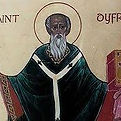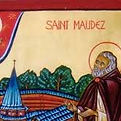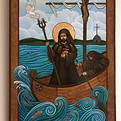The Orthodox Church of St. Cosmas & St. Damian,
Ipswich, Suffolk
Archdiocese of Thyateira and Great Britain
Ecumenical Patriarchate




British and Irish Saints of the Month
(Including saints having a connection with these lands.)
When the Church in the British Isles begins to venerate her own saints, then the Church there will grow. - St Arsenios of Paros. (1877)
NOVEMBER
.jpg)
1st St Cadfan of Bardsey (6th).
He founded a monastery at Towyn, near Aberdovey in Wales which existed until the thirteenth century. Water from Cadfan’s holy well reputedly cured rheumatism and skin disorders, with a small spa existing there into the nineteenth century. He later founded a monastery at Bardsey.
.jpg)
3rd St Winifred (Winifride) of Treffynon (Holywell)
(N Wales 7th).
She was abbess of a monastery in Wales. She is a well-known and popular saint, especially in Wales, mainly on account of St Winifred’s Well which is in the centre of the town of Holywell in the far north-eastern corner of Wales. The well is thought to be from early pagan times, but became associated with St Winifred. It is a national shrine and has been a place of pilgrimage for Christians for more than 900 years.
.jpg)
6th St Illtyd, Abbot of Llanilltyd Fawr (6th).
Little is known of this saint. He was said to be a great teacher, having established a monastic school for children and clergy at Llanilltyd Fawr which is a village on the extreme south coast of Wales. The school was a cradle of Celtic Christianity.
.jpg)
10th St Aedh (MacBricc), Bishop of Meath (6th).
Not a well-known saint even in Ireland, but he laboured in Co Donegal, and was noted as a spiritual guide to women, and as being sympathetic to young women who had fallen into sin.

10th St Justus, Archbishop of Canterbury (627).
First, he was Bishop of Rochester, and then was fourth Archbishop of Canterbury. Noted as an assistant to St Augustine in the evangelisation of the English. What we know about him is in St Bede’s Ecclesiastical History.
.jpg)
11th St Martin the Merciful, Bishop of Tours (397).
Though a saint of France, St Martin has always been much venerated in England. Indeed, St Martin’s Church in Canterbury is the oldest active church in England, dating from before 597. St Martin-in-the Fields in London is a very famous church whose origins date from Roman times. The Antiochian Orthodox Church in Colchester, Essex, is dedicated to St Martin, the dedication dating from very early times. The story of St Martin, a Roman army officer, giving a beggar half his military cloak is well known and much depicted in art. He was the third Bishop of Tours.
.jpg)
12th St Machar, Bishop of Aberdeen (6th).
This saint was of Irish origin, and was baptised by St Colman. He went to Iona with St Columba, and then went to preach to the Picts in eastern Scotland, becoming, one source says, the first Bishop of Aberdeen. Nothing else is known about him for certain.
.jpg)
14th St Dyfrig, Bishop in Hereford and Gwent, Hermit of Bardsey Island (c 550).
He was born in Herefordshire and is associated with south-east Wales. As a child he was noted for his intellect, and by the time he was a man he was known as a scholar throughout Britain. He founded a college in Herefordshire to which many scholars, including St Illtud, came. Dyfrig later moved further up the Wye to found an abbey. While he was abbot he was chosen to be the first Bishop of Llandaff. He laboured long and hard against the Pelagian heresy. He retired to live as a hermit on Bardsey Island.
.jpg)
17th St Hilda of Whitby, Abbess (680).
One of the great saints of England and the greatest of our women saints. The University of Oxford has a college named after her. Most of what we know about St Hilda is from Bede who praises her very highly. She became a nun at the age of 33, and intended to join her sister at a monastery in France, but St Aidan asked her to return to Northumberland. After being abbess of the monastery at Hartlepool, she founded the monastery at Whitby. Like many monasteries in England in those times, this was a double monastery with communities of monks and of nuns. (We may think of the double monastery at Tolleshunt Knights.) Bede praises Hilda for implementing a monastic regime that required strict observance of ‘justice, piety, chastity’ and ‘particularly of peace and charity’. In her monastery, ‘no one there was rich, and none poor, for they had all things common’. Hilda was a woman of great energy, who was a skilled administrator and teacher. As a landowner she had many in her employ to care for sheep and cattle, for farming and woodcutting. She gained such a reputation for wisdom that kings and princes sought her advice. However, she also had concern for ordinary folk such as Caedmon. He was a herder at the monastery, who was inspired in a dream to sing verses in praise of God. Hilda recognized his gift and encouraged him to develop it. Bede writes, ‘All who knew her called her mother because of her outstanding devotion and grace.’ Such was the prestige of the monastery that it was chosen to host the Synod of Whitby in 664. Hilda suffered from illness during the last seven years of her life.
.jpg)
18th St Mawes, Bishop in Cornwall and Brittany (5th).
The origins of St Mawes are uncertain save that he was a Celt. He started his mission in the settlement in Cornwall named after him. He is thought to have been a bishop there. However, he later crossed to Brittany with which he is mostly associated.
_reverse.jpg)
19th St Egbert, Archbishop of York (766).
Egbert, cousin of King Ceolwulf of Northumbria, to whom Bede dedicated his history, succeeded Wilfrid II as Bishop of Northumbria in 732. He became the second Archbishop of York. Egbert stepped at once into a commanding position and every bishop in the northern province was made his suffragan. Egbert was a stern disciplinarian and it was soon after his consecration to the see that Bede addressed to him his well-known letter, setting forth the disorder and corruption of the whole northern diocese. Evils which, throughout his episcopate, Egbert sought by every means to reform. He was probably the first to introduce the parochial system in the north and was certainly the founder of the famous monastic school of York and of the library connected with it. In this school, Alcuin was educated.
.jpg)
20th St Edmund, King and Martyr (869).
Edmund was king of East Anglia from about 855 until his death. Few historical facts about Edmund are known since the kingdom of East Anglia was devastated by the Vikings who destroyed any contemporary evidence of his reign. His relics were at the cathedral of Bury St Edmunds, and veneration of St Edmund began soon after his martyrdom by the Vikings. He became England’s patron saint until he was replaced by St George in the 15th century.
.jpg)
22nd Hieromartyr Deiniol the Younger, Abbot of Bangor (621).
The origins of St Mawes are uncertain save that he was a Celt. He started his mission in the settlement in Cornwall named after him. He is thought to have been a bishop there. However, he later crossed to Brittany with which he is mostly associated.

23rd St Columbanus of Ireland, Abbot of Luxeuil & Bobbio (615).
Born in Ireland and as a young man noted for both his academic ability and his good looks. Whilst in his youth, he met an anchoress who encouraged him to embrace the religious life. He left the district travelling to Comgall’s austere monastery in Bangor where he remained for a considerable time, studying theology, Latin and Greek. He later travelled to Gaul and established monasteries living according to Irish monastic observances. One of these, Luxeuil, was built in a Roman ruin, a hill fort. Within a short time, followers spread all over Europe, and churches and monasteries were established in France, Germany, Italy and Switzerland. He and his monks established a monastery at Bobbio, between Milan and Genoa, noted for its teaching and spirituality.
_edited.jpg)
24th St Colmán, Bishop of Cloyne (c 606).
He was a monk, founder and patron of Cluain Uama, now Cloyne, County Cork, Ireland, and one of the earliest known Irish poets. He was a native of Cork and for many years the royal bard of Cashel. He was converted to Christianity by St Brendan of Clonfert.
.jpg)
24th St Enfleda, wife of St Oswy, King of Northumbria (c 704).
Enfleda was the queen of the pious King Oswiu of Northumbria who died in 670. She was a supporter of the Roman cause at the Synod of Whitby, and was a patron of St Wilfrid. The widowed Enfleda retired to the monastery at Whitby where her daughter Elfreda was also a novice. She succeeded St Hilda as abbess.
_edited_edited.jpg)
29th St Brendan of Birr (573).
He was a friend of Columba and also a contemporary of Brendan the Voyager. He was known as the ‘Chief of the Prophets of Ireland,’ and after his death, Columba, many miles away on Iona, was granted a vision of his soul being received by the angels.

30th St Tudwal, Bishop in Wales and Brittany (6th).
Tudwal was a Welsh monk and bishop. Originally a monk in Wales, he journeyed Ireland for his education. Then, he spent time as hermit on what is now called St Tudwal’s Island off the coast of the Llŷn Peninsula in North Wales. He later went to Brittany, France, with his mother, sisters, and other relatives. The Celtic language of Brittany was easily understood by Welsh speakers. Tuwal was thus one of several Celtic saints who evangelised Brittany.